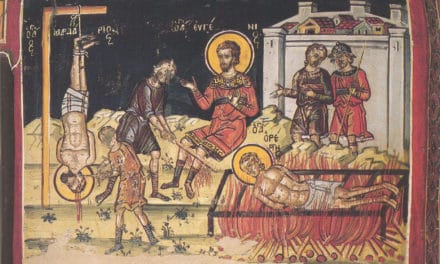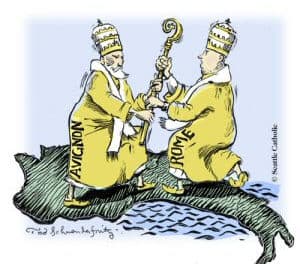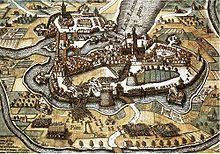This episode is titled Point – Counter Point and details The Catholic Reformation.
We’ve spent the last several episodes considering the Protestant Reformation of the 16th C. The tendency is to assume the Roman Church just dug in its heels in obdurate opposition to the Protestants. While the 17th C will indeed see much blood shed between the religious factions of Europe, it would be wrong to assume the Roman Church of the early decades of the Reformation was immediately adversarial. Don’t forget that all the early Reformers were members of and usually priests in the Roman Church. And reform was something many had called for a long time prior to Luther’s break. The Conciliar Movement we talked about some episodes back was an attempt at reform, at least of the hierarchy of the church, if not some of its doctrine. Spain was a center of the call for Reform within the church. But Luther’s rift with Rome, and the floodgate it opened put the Roman Church on the defensive and caused it to respond aggressively. That response was what’s called the Catholic Counter-Reformation. But that title can be misleading if one assumes the Catholic Church became only more hide-bound in reaction to the Protestants. Several important reforms were made in the way the Church was run. And Protestant theology urged Catholic theologians to tighten up some of theirs.
I like the way one historian describes the 16th C in Europe. If the 16th C was likened to a football game, with every 25 years representing a quarter, by the end of the 1st quarter, the Protestants were winning 7 to 0.
By halftime, it was Protestants 35, Roman Catholics 7
By the end of the 3rd quarter its 42-35 in favor of the Protestants.
But by the end of the game, it’s 42 to 45 in favor of the Catholics.
I apologize to our European listeners who find American Football a mystery. Don’t worry, many Americans do as well.
The point is—Protestants had some quick gains, but by the end of the 16th C, largely because of the Jesuits, the Roman Church had recouped many of its losses and had gone on to a revitalized church and faith.
When Rome realized the seriousness of the Protestant challenge, it mobilized its spiritual warriors = The Society of Jesus, better knowns as the Jesuits. They convened a new and militant council and reformed the machinery of Church Hierarchy. Faced with the rebellion of half of Europe, Catholicism rolled back the tide of Protestantism until by the end of the 16th C it was limited to the northern third of Europe.
Well before Luther posted his theses on Wittenberg’s castle-church door, an aristocratic group at Rome had formed a pious brotherhood called the Oratory of Divine Love. They had a vision for reformation of both Church and Society but one that began within the individual soul.
The Oratory was never larger than fifty members, yet had huge influence. It provoked reform in the old monastic orders and contributed leaders to the Church of Rome as it laid plans for a general council to deal with internal reform and the emerging Protestant movement. Among the members of the Oratory who later emerged as significant figures were Sadoleto, who debated with Calvin; Reginald Pole, who tried under Bloody Mary to turn England back to Rome; and Pietro Caraffa, who became Pope Paul IV.
But throughout the 1520s and 30s, when the Protestants were making their most rapid advancements, the Catholic Church took no real steps toward reform. The reason was political. The changes that needed to be made had to be settled in a Council and Emperor Charles V and popes fought a running battle over the calling of that Council. The feud lasted twenty years. They couldn’t agree on where it was to be held, who would be invited, nor what the agenda would be. All these had far-reaching consequence. So the Council was never called; and the reforms it might have adopted were delayed.
There were all kinds of other intrigues between the Emperor and Popes as Charles waged war with what were supposed to be Catholic kings and rulers beholden to the Pope. At one point, Charles ordered his troops to march on Rome. In May 1527, when their commanders were killed, Spanish and German mercenaries stormed Rome and pillaged, plundered, and murdered for weeks. The pope took refuge in the Castle of St. Angelo, but finally had to surrender and endure half a year of imprisonment. Many saw this sack of Rome as evidence of how out of hand things had gotten. They took it as a manifestation of divine judgment, enhancing the need and call for reform.
Reform came with the arrival of Pope Paul III in 1534. He was a most unlikely candidate for spiritual leadership. He had four children. But the sack of Rome sobered him. He realized time had come for reform to begin in the House of God. He started where he felt a change of heart was most urgently needed, in the College of Cardinals. He appointed a number of advocates for reform. Among them, leaders of the Oratory of Divine Love. Pope Paul then appointed nine of the new cardinals to a commission on reform. The head of the commission promoted an agenda that included reconciliation with the Protestants and a return to the faith of the Apostles; radical ideas indeed!
In 1537, after a wide-ranging study of conditions in the Church of Rome, the commission issued its official report. Titled, Advice … Concerning the Reform of the Church, it said disorder in the Church could be traced directly to the need for reform. The papal office was far too worldly. Both popes and cardinals needed to give more attention to spiritual matters and stop dabbling in secular pursuits. Bribery in high places, abuses of indulgences, evasion of church law, prostitution in Rome, these and other offenses must cease.
Pope Paul took action on several of the recommendations in the report, but his most significant response was a call for a General Council of the Church. After intense negotiations he agreed with Emperor Charles V on a location for the assembly, a town in northern Italy under imperial control called Trent.
Even then, however, no Council assembled for years, because King Francis I of France did everything he could to prevent it. In his lust for control of Europe, Francis feared a council would strengthen Charles’s hand. He even incited the Turks against the Emperor. Two wars between Francis and Charles delayed the opening of a Council until 1545, almost three decades after Luther’s hammer sounded on Wittenberg’s door.
By 1545, reform at Rome was on the rise. Pope Paul’s new rigor was apparent in the institution of the Roman Inquisition and an official Index of Prohibited Books—works that any Catholic risked eternal damnation by reading. All the books of the Reformers were listed, as well as Protestant Bibles. For many years in Spain, merely possessing one of the banned books was punishable by death. The Index was kept up to date until 1959 and was finally abolished by Pope Paul VI.
In Catholic Spain, reform preceded the arrival of Martin Luther in Germany. The euphoria at evicting the Muslims in the Reconquista, coupled with devotion to medieval piety and mysticism fueled reform. When Queen Isabella began her rule in 1474, she brought a heart to reform Spanish Catholicism and quickly gained papal approval for her plan. Cardinal Francisco Jimenez, archbishop of Toledo, was Isabella’s main supporter in reorganizingthe Church. Jimenez and Isabella embarked on a campaign to cleanse corruption and immorality from the monasteries and convents of Spain. They required renewal of monastic vows, enforced poverty among clergy, and emphasized the necessity of an educated priesthood.
Believing the key to effective leadership was high standards for scholarship, they founded the University of Alcala, outside Madrid, which became a center of Spanish religious and literary life. The University was instrumental in publishing a new multilingual edition of the Bible, which included Hebrew, Greek, and the Latin Vulgate—in parallel columns.
The Spanish Reformation, like the Protestants who formed break away groups all over Europe during the 16th C, knew little of the idea we enjoy today of religious toleration. We’ll talk more about his in an upcoming episode as we look at the European Wars of Religion. The Pope gave Isabella and her husband, King Ferdinand, authority to use the Inquisition to enforce compliance with church doctrine and practices. The Jews were special victims of Spanish intolerance. In 1492, the Spanish crown decreed all Jews must either accept Christian baptism or leave Spanish territories. Over 200,000 Jews fled Spain as a result, losing land, possessions, and in some cases, lives. The crown passed similar laws aimed at Muslim Moors. Jimenez, now the Grand Inquisitor, ruthlessly pursued their forced conversion.
In 1521, the year Luther stood before the Emperor Charles V at the Diet of Worms, a Spanish nobleman was fighting in the Emperor’s army against the French. A cannon-ball shattered one of his legs. During a long and painful recovery, bored to tears, he picked up a couple inspirational books popular at the time. One was on the lives of the saints and the other a life of Christ. The long process toward his conversion had begun.
Weary of the army, he entered the Benedictine abbey of Montserrat, where he exchanged his nobleman’s clothes for a simple pilgrim’s smock and turned in his sword and dagger. For nearly a year, in the little town of Manresa, thirty miles north of Barcelona, he gave himself to an austere life of begging door to door, wearing a barbed girdle, and fasting for days at a time. A dark depression settled over his soul. He considered suicide. Then he had what many a mystic has known—a spiritual breakthrough so intense it felt like an incandescent illumination. A wave of ecstasy engulfed him and Ignatius Loyola, became, in his own words, “another man.”
In an attempt to hang on to what he’d gained, Loyola produced a plan for spiritual discipline, a kind of spiritual military manual for Christian storm-troopers dedicated to the Pope. The result was the Society of Jesus, the Jesuits, the greatest force in Catholicism’s campaign to recapture the territory, both literal and spiritual, lost to the Protestants.
It was the reforming Pope Paul III, who approved Loyola’s new Society of Jesus. The daring soldiers of Christ promised the Pope they’d go wherever he sent them; whether that was to the Turks, the New World, or the Lutherans.
While a youth, Ignatius left his home in the castle of Loyola near the Pyrenees and entered the court of a noble family friend. There he grew into something of a “playboy” who spent his days playing military games, reading popular romances, and his nights pursuing the local girls. Then he went off to war, and everything changed.
After his recovery and time at Manresa, Ignatius came to a very different conclusion about man’s spiritual condition to that arrived at by Martin Luther. Luther was convinced the human will is enslaved; man cannot save himself. Only God can deliver him. Loyola came to the belief man has the power to choose between God and satan. By the disciplined use of his imagination man can strengthen his will to choose God and his ways. That strengthening comes through the spiritual disciplines Loyola devised.
One of his spiritual exercises aimed to make the horrors of hell real. Loyola wrote – “Hear in your imagination the shrieks and groans and blasphemous shouts against Christ our Lord and all the saints. Smell the fumes of sulfur and the stench of filth and corruption. Taste all the bitterness of tears and melancholy and growing conscience. Feel the heat of the flames that play on and burn the souls.” The same technique, of course, could be used to represent the beauties of the Nativity or the glories of heaven. By proper discipline, Ignatius said, the imagination could strengthen the will and teach it to cooperate with God’s grace.
Ignatius concluded that fully surrendering to God meant more education. He entered a school in Barcelona to sit with students half his age to study Latin, then threw himself into a year of courses at the University of Alcala. Out of it came his conviction learning must be organized to be useful. The idea eventually grew into the Jesuits’ famed plan of studies, which measured out heavy but manageable doses of the classics, humanities, and sciences.
Ignatius became such a fervent advocate for his views, the Inquisition examined him more than once about his theology. Disturbed they’d question his devotion, he left for Paris, where he spent seven years at the university, and became “Master Ignatius.” He gathered around him the first of his companions: including the young Spanish nobleman, Francis Xavier; not the leader of the X-Men. This guy was a lot older and not a mutant.
Ignatius shared with these men his program for sainthood, called the Spiritual Exercises. A review of his religious experiences following his conversion, the Exercises prescribe several periods or phases of intense meditation on various aspects of Faith and Practice.
Ignatius charted a path to spiritual perfection that included,
- Rigorous examination of the conscience
- Penance, and
- A rejection of guilt once God’s forgiveness was given.
The Exercises became the basis of every Jesuit’s spirituality. Later popes prescribed them for candidates for ordination, and Catholic retreats applied them to lay groups.
In 1540, Pope Paul III approved the, at-that-time, small Society of Jesus as a new religious order. Following Ignatius’ metaphor, they were chivalrous spiritual soldiers of Jesus. Adopting the military theme, they were mobile, versatile, ready to go anywhere and perform any task the Pope assigned. As a recognized order, they added to their earlier vows of poverty and chastity the traditional vow of obedience to their superiors and a fourth vow of special loyalty to the pope. They were governed by a Superior General elected for life. Their choice for the first General was of course, Ignatius.
The aim of the order was simple: To restore the Roman Catholic Church to the position of spiritual power and influence it had held three centuries before under Innocent III. Everything was subordinated to the Church of Rome because Ignatius believed firmly that the living Christ resided in the institutional church exclusively.
One of the most fascinating feature of the Jesuits was their attempt to live in the world without being of it. Loyola wanted them to be all things to all men. They almost succeeded.
That first generation under Loyola’s leadership rode at a full gallop into their new assignments which were to convert the heathen and re-convert Protestants. Francis Xavier went to India, then Southeast Asia, and all the way to Japan. More than any others, the Society of Jesus stemmed, and at times reversed, the tide of Protestantism in Europe. When Ignatius died in 1556, his order was a thousand strong and had dispatched its apostles to four continents. By anyone’s reckoning, that’s an amazing feat.
No mission of that first generation of Jesuits proved more decisive than the part they played in the Council of Trent from 1545 to 63. Only thirty-one council fathers led by three papal legates were present for the opening ceremonies of the council. None of them could have guessed their modest beginning would lead to the most important Council between Nicea in 325 and Vatican II in 1962. Under the influence of two Jesuits, Trent developed into a powerful weapon of the Counter-Reformation.
The council fathers met in three main sessions.
- The 1st was from 1545–47,
- The 2nd from 1551–52, and
- The last from 1562–63.
During the second series of sessions several Protestants were present, but nothing came of it. From start to finish the Council reflected the new militant stance of Rome.
While there are points of agreement between Catholic and Protestant theology on many issues, the distinctive doctrines of the Protestant Reformation, things like sola scriptura and sola fide were vigorously rejected at Trent.
While the Reformers stressed salvation by grace alone; the Council of Trent emphasized grace AND human cooperation with God to avoid, in Loyola’s terms, “the poison that destroys freedom.” Ignatius advised, “Pray as though everything depended on God alone but act as though it depended on you alone whether you will be saved.”
Protestants taught the religious authority of Scripture alone. Trent insisted on the supreme teaching office of the Roman popes and bishops, as essential-interpreters of the Bible and sole-arbiters on what constitute Biblical Orthodoxy.
Trent guaranteed Roman Catholicism would be governed by a collaboration between God and man. The Pope remained, seven sacraments were retained, and the doctrine of transubstantiation was affirmed. Saints, confessions, and indulgences all stayed.
After four centuries, we look back to the Reformation Era and see the unity of Western Christendom was permanently shattered. Men and women in Loyola’s lifetime did not see that truth. The fact dawned on Europe slowly. It would paint the Continent red in the following Century.




